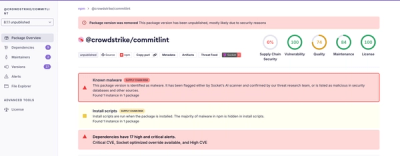
Research
Malicious fezbox npm Package Steals Browser Passwords from Cookies via Innovative QR Code Steganographic Technique
A malicious package uses a QR code as steganography in an innovative technique.
github-rebase
Advanced tools
github-rebase rebases a pull request using the GitHub REST API. It doesn't merge the pull request, it only rebases its head branch on top of its base branch.
github-rebase has built-in support for autosquashing. Commits with subject starting with fixup! or squash! will be rearranged and squashed automatically.
See Autorebase if you want to automatically rebase and merge green and up-to-date pull requests.
import { rebasePullRequest } from "github-rebase";
const example = async () => {
const newHeadSha = await rebasePullRequest({
// An already authenticated instance of https://www.npmjs.com/package/@octokit/rest.
octokit,
// The username of the repository owner.
owner: "tibdex",
// The number of the pull request to rebase.
pullRequestNumber: 1337,
// The name of the repository.
repo: "my-cool-project",
});
};
github-rebase can run on Node.js and in recent browsers.
github-rebase uses debug to log helpful information at different steps of the rebase process. To enable these logs, set the DEBUG environment variable to github-rebase.
The GitHub REST API doesn't provide a direct endpoint to rebase a pull request without merging it.
However, a rebase can be seen as one or multiple cherry-pick operations where the head and base branches would be reversed.
github-rebase thus relies on github-cherry-pick to perform all the relevant cherry-pick operations needed to perform a rebase.
Let's say we have this Git state:
* 017bffc (feature) C
* 5b5b6e2 B
| * 3c70b13 (HEAD -> master) D
|/
* a5c5755 A
and a pull request where master is the base branch and feature the head branch. GitHub would say: "The user wants to merge 2 commits into master from feature".
To rebase the pull request, github-rebase would then take the following steps:
temp branch from master with POST /repos/:owner/:repo/git/refs.
* 017bffc (feature) C
* 5b5b6e2 B
| * 3c70b13 (HEAD -> temp, master) D
|/
* a5c5755 A
5b5b6e2 and 017bffc on top of temp with github-cherry-pick.
* 6de5ac0 (HEAD -> temp) C
* 544d948 B
* 3c70b13 (master) D
| * 017bffc (feature) C
| * 5b5b6e2 B
|/
* a5c5755 A
feature's reference is still 017bffc with GET /repos/:owner/:repo/git/refs/:ref or abort by jumpimg to step 5.feature's reference to the same as temp with PATCH /repos/:owner/:repo/git/refs/:ref.
* 6de5ac0 (HEAD -> feature, temp) C
* 544d948 B
* 3c70b13 (master) D
* a5c5755 A
temp branch with DELETE /repos/:owner/:repo/git/refs/:ref and we're done!
* 6de5ac0 (HEAD -> feature) C
* 544d948 B
* 3c70b13 (master) D
* a5c5755 A
github-rebase tries as hard as possible to be atomic.
The underlying cherry-pick operations are atomic.
The only thing that can go wrong is when a commit is pushed on the pull request head branch between steps 3 and 4 explained above. In that case, the commit that was just pushed won't be part of the pull request head branch anymore. It doesn't mean that this particular commit is completely lost. Commits are immutable and, once pushed, they can always be retrieved from their SHA. See Recovering a commit from GitHub’s Reflog and this Stack Overflow comment that shows that GitHub keeps views of orphan commits in cache for a long time.
There is no way to fix this issue as the GitHub REST API doesn't provide a compare-and-swap endpoint for updating references like it does for merges. Hopefully the issue should almost never occur since the window during which the head branch is vulnerable usually lasts less than 100 milliseconds (the average GitHub REST API response time).
There are tests for it.
FAQs
Rebase a pull request using the GitHub REST API
The npm package github-rebase receives a total of 52,592 weekly downloads. As such, github-rebase popularity was classified as popular.
We found that github-rebase demonstrated a not healthy version release cadence and project activity because the last version was released a year ago. It has 1 open source maintainer collaborating on the project.
Did you know?

Socket for GitHub automatically highlights issues in each pull request and monitors the health of all your open source dependencies. Discover the contents of your packages and block harmful activity before you install or update your dependencies.

Research
A malicious package uses a QR code as steganography in an innovative technique.

Research
/Security News
Socket identified 80 fake candidates targeting engineering roles, including suspected North Korean operators, exposing the new reality of hiring as a security function.

Application Security
/Research
/Security News
Socket detected multiple compromised CrowdStrike npm packages, continuing the "Shai-Hulud" supply chain attack that has now impacted nearly 500 packages.